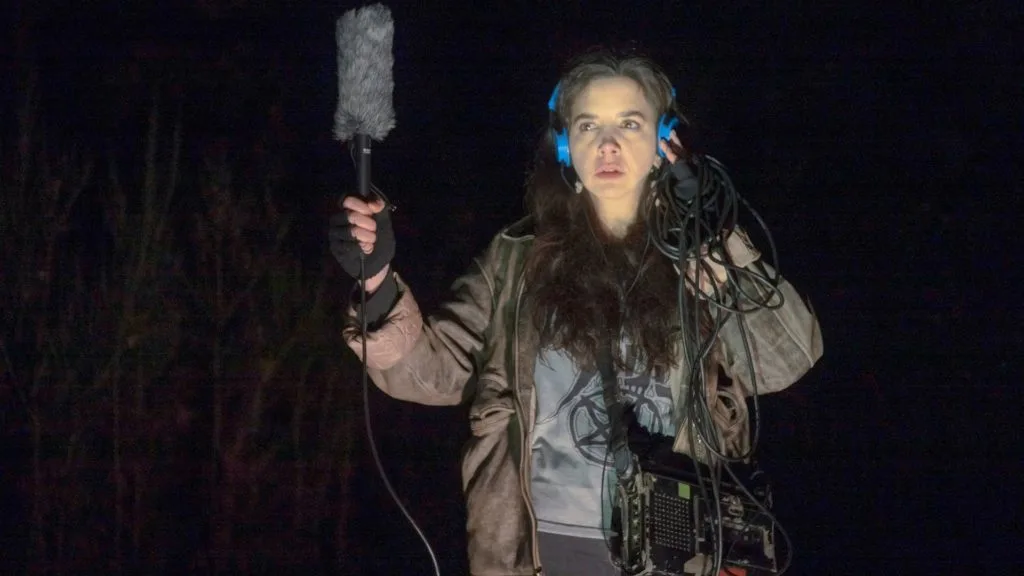
Invoking Yell (2023) is clearly a film that likes to layer its influences, giving us a grab-bag of themes and styles. These chiefly being: found footage; 90s-style analogue cameras; the EVP phenomenon and the film’s biggest, boldest theme – 90s black metal. By way of some on-screen text at the start, the film explains that, when the second wave of black metal started to break in the 1990s, bands needed to constantly think up new ways to distinguish themselves from the now-burgeoning scene. The film starts from this point and, actually, turns out to be more a kind of time capsule of this point in time than a straightforward horror film, but the end result – a look at how obsessions and mythologies overlap and establish themselves – is quite interesting on its own terms.
In the world of the film, female Chilean two-piece Invoking Yell have the answer (the band plays Depressive Suicidal Black Metal, by the way and yeah, DSBM is an actual genre.) Band member Andrea (María Jesús Marcone) – who takes all of this really seriously – has started to use a blend of field recordings and EVP to flesh out the band’s early demo recordings. She refers to this as psycophony, and not only does it sound pretty cool, but it makes their music authentically evil: what could distinguish them more than that? Together with bandmate Tania (Macarena Carrere) and Ruth (Andrea Ozuljevich), a-girl-with-a-camera who is interested in joining the band, they are on a mission to head out into the woods to the site of an accident, where a bus careered off the road and flipped, killing a number of children travelling inside.
As far as Andrea sees it, this is a good thing: if she can capture the tormented screams of the dead, that will really push the envelope on their four-track, because it will be an authentically cursed artefact. Whilst they’re in the woods, this is also a good opportunity to make an Immortal-style promo video. The girls have rented a cabin: they head there first of all, settle in (with a little squabbling over bedrooms) but before long, they’re at work, making an excursion out to what they believe to be the haunted site.
There’s the standard lull at this point, the one which typically comes between ‘meeting the characters’ and ‘something spooky happening’. Invoking Yell affords time to the girls talking about their musical influences, the ‘scene’, and perhaps most importantly, how they see what they are doing as authentic ritual, which later necessitates actually holding a ritual. There’s some justifiable teasing of the black metal ethos here, capturing some of its absurdities and po-faced posturing, though it has to be said: it’s all knowing enough to feel properly in earnest, rather than a laugh from a complete outsider which misses the mark. Other than that, the film spends time capturing something of that weird significance you grant to things which exist outside your comfort zone, perhaps especially when you’re young and retain more imagination; abandoned buildings, graffiti, lost objects, these can all take on terrific and onerous meanings. But on the other side of that coin is the way the young often display bravado when it turns out they’re somewhere with a disturbing history; Andrea and Tania like to giggle and posture in locations they believe to be multiple death sites. Black metal can’t quite account for all of that attitude; it’s elsewhere too, but it tends to be a youth thing. Older people don’t court it in the same way, for the most part.
For once, the shooting style – the now-ubiquitous fantasy of ‘snow’, static and other analogue features – isn’t such a bother, because within the timeframe chosen and the musical genre which pins things together, it’s a more authentic-feeling thing. The shifting frame is a little irritating, alright, but not out of place. Ruth openly threatens Super 8 coverage, and we have a Polaroid camera in-shot a lot of the time; consistent enough. It’s explained as the girls want to get that visually-appealing lo-fi look. In-between, you actually get to see some impressive filming locations, though not for long. There is also a lot of dialogue here; it is a film busy with dialogue, with acres of chit-chat on bands, genres, interpersonal issues. Again, no plausibility issues with this, but as a non-Spanish speaker, it’s quite a read.
What you may notice from this review so far is a lot of attention being paid to the film’s technical aspects – shooting style, dialogue, location. The reason for this is that there is very little plotline to really discuss; what you already know, you know. It’s an immensely simple set-up in any case which looks to be heading in one kind of direction, but ultimately, it only tantalises at those kinds of scares. This is a shame – the phenomenon of EVP has the capacity to trample my rational thoughts into mulch within minutes – and by its end credits Invoking Yell turns out to have been far more of a glimpse at the 90s black metal scene than a straightforward horror film. This it does better than the likes of Lords of Chaos, mind you, so there’s much to be said for it. Here’s a film which uses aspects of horror as much as it is a horror, and it may be lost on complete outsiders in some respects, but it’s appealing and evocative in plenty of ways.
Invoking Yell (2023) premiered at PanicFest and will be hitting its festival run later this year.
